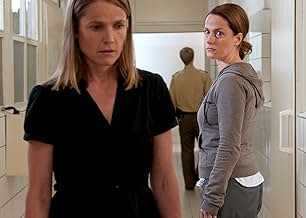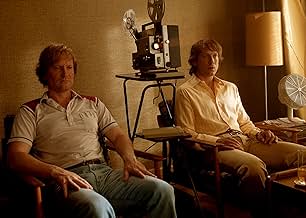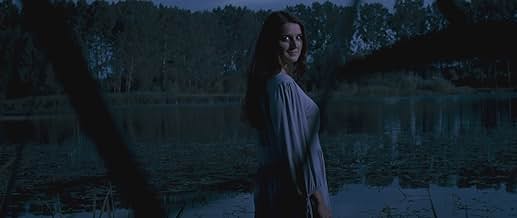IMDb-BEWERTUNG
6,9/10
8696
IHRE BEWERTUNG
Die 13-jährige Sinikka verschwindet in einer heißen Sommernacht. Ihr Fahrrad wird genau dort gefunden, wo vor 23 Jahren ein Mädchen getötet wurde. Die dramatische Gegenwart zwingt die Beteil... Alles lesenDie 13-jährige Sinikka verschwindet in einer heißen Sommernacht. Ihr Fahrrad wird genau dort gefunden, wo vor 23 Jahren ein Mädchen getötet wurde. Die dramatische Gegenwart zwingt die Beteiligten des ursprünglichen Falles, sich ihrer Vergangenheit zu stellen.Die 13-jährige Sinikka verschwindet in einer heißen Sommernacht. Ihr Fahrrad wird genau dort gefunden, wo vor 23 Jahren ein Mädchen getötet wurde. Die dramatische Gegenwart zwingt die Beteiligten des ursprünglichen Falles, sich ihrer Vergangenheit zu stellen.
- Regie
- Drehbuch
- Hauptbesetzung
- Auszeichnungen
- 1 Gewinn & 4 Nominierungen insgesamt
Amon Wendel
- Malte
- (as Amon Robert Wendel)
Lena Klenke
- Sinikka
- (as Anna-Lena Klenke)
Helene Luise Doppler
- Pia
- (as Helene Doppler)
Empfohlene Bewertungen
Most murders are committed by people who know their victim, a fact that is standard fare in most whodunits. Rarely are murders committed at random, although the recent horrific thriller Funny Games (1997, remade 2007) presents the worst possible scenario.
But random murders do occur in real life: all over the world, people disappear and forever remain 'dead' with family and friends who are forever in limbo, unable to achieve closure. Only sometimes are the perpetrators caught.
With that thematic background, The Silence presents just that scenario with the rape and murder of a young female teen that remains on the books of the local police for 23 years – until it happens again to another teen, on the same day of the year, at the same place, and with the same modus operandi.
Unlike other serial killer movies – for example, The Silence of the Lambs (1991) – we know the identity of the killer from the get-go. Moreover, we also immediately know there are two perpetrators, although one of them is obviously reluctant to participate, even passively as he watches. As the two criminals, Ulrich Thomsen (as Peer Sommer) and Woltan Mohring (as Timo Friedrich) give strong and believable performances that center upon their individual but similar proclivities for depravity: brave actors both to take on such abhorrent roles.
But why a gap of 23 years? Well, that's where the story really starts, after we see the first murder in the first five minutes. And when the second murder occurs, so also occurs the retirement party for the local police detective (Krischan Mittich played by Burghart Klaussner) who failed to solve the first; so also the return to duty of an eccentric, grieving, widowed officer (David Jahn played by Sebastian Blomberg) who is obviously still distraught by the loss of his wife (to cancer) and who engages in bizarre activity; and so also the emotional awakening of the mother of the first murdered teen (Elena Lange played by Katrin Sass), who has been locked in unrelenting grief for over twenty years.
And in that mix there is repressed and introverted Timo – now a successful architect, beautiful home, lovely wife, two munchkins, the works – who, when he reads about the second murder, knows immediately who it is and decides something must be done But, what?
As the police investigate, and as the clues are revealed, the net – so to speak – tightens without the two miscreants knowing. But, as viewers, we know it all, and gradually we move to the edge of our seat as we see how the wrong decisions are made, how the wrong inferences are drawn, how actions by one can be misconstrued by another all too easily, and ultimately how facts can be ignored or discarded for political expediency or professional jealousy and for the need to close a case, once and for all.
Arguably, suspenseful story doesn't get much better than this; although some viewers might argue about narrative holes and coincidence. However, because it's so believable it's so much better, especially the ending which I'm sure many – maybe most – viewers will not see coming, including me. Only in the last thirty seconds, perhaps when the full irony hits you between the eyes.
The setting is semi-rural, ordinary and faultless; the production is well paced, even at two hours; the dramatic acting – there is absolutely no comic relief – is flawless; and the direction is so good, well, a glance or look truly is more effective than a thousand words. The background music is appropriate but, at times, borders on clichéd, I think. However, this is a movie I'll watch again – not only for the story but also for the narrative structure that combines so many different threads of lives shattered by indifference, inaction, inadequacy or inconsolable sadness.
Highly recommended.
November 2011.
But random murders do occur in real life: all over the world, people disappear and forever remain 'dead' with family and friends who are forever in limbo, unable to achieve closure. Only sometimes are the perpetrators caught.
With that thematic background, The Silence presents just that scenario with the rape and murder of a young female teen that remains on the books of the local police for 23 years – until it happens again to another teen, on the same day of the year, at the same place, and with the same modus operandi.
Unlike other serial killer movies – for example, The Silence of the Lambs (1991) – we know the identity of the killer from the get-go. Moreover, we also immediately know there are two perpetrators, although one of them is obviously reluctant to participate, even passively as he watches. As the two criminals, Ulrich Thomsen (as Peer Sommer) and Woltan Mohring (as Timo Friedrich) give strong and believable performances that center upon their individual but similar proclivities for depravity: brave actors both to take on such abhorrent roles.
But why a gap of 23 years? Well, that's where the story really starts, after we see the first murder in the first five minutes. And when the second murder occurs, so also occurs the retirement party for the local police detective (Krischan Mittich played by Burghart Klaussner) who failed to solve the first; so also the return to duty of an eccentric, grieving, widowed officer (David Jahn played by Sebastian Blomberg) who is obviously still distraught by the loss of his wife (to cancer) and who engages in bizarre activity; and so also the emotional awakening of the mother of the first murdered teen (Elena Lange played by Katrin Sass), who has been locked in unrelenting grief for over twenty years.
And in that mix there is repressed and introverted Timo – now a successful architect, beautiful home, lovely wife, two munchkins, the works – who, when he reads about the second murder, knows immediately who it is and decides something must be done But, what?
As the police investigate, and as the clues are revealed, the net – so to speak – tightens without the two miscreants knowing. But, as viewers, we know it all, and gradually we move to the edge of our seat as we see how the wrong decisions are made, how the wrong inferences are drawn, how actions by one can be misconstrued by another all too easily, and ultimately how facts can be ignored or discarded for political expediency or professional jealousy and for the need to close a case, once and for all.
Arguably, suspenseful story doesn't get much better than this; although some viewers might argue about narrative holes and coincidence. However, because it's so believable it's so much better, especially the ending which I'm sure many – maybe most – viewers will not see coming, including me. Only in the last thirty seconds, perhaps when the full irony hits you between the eyes.
The setting is semi-rural, ordinary and faultless; the production is well paced, even at two hours; the dramatic acting – there is absolutely no comic relief – is flawless; and the direction is so good, well, a glance or look truly is more effective than a thousand words. The background music is appropriate but, at times, borders on clichéd, I think. However, this is a movie I'll watch again – not only for the story but also for the narrative structure that combines so many different threads of lives shattered by indifference, inaction, inadequacy or inconsolable sadness.
Highly recommended.
November 2011.
Baran bo Odar's film begins almost wordlessly on a sunny day in 1986. Two men driving along in a red car (Ulrich Thomsen, Wotan Wilke Möhring) encounter a young girl riding a bicycle (Helene Doppler). They pursue her into a cornfield where one of the men rapes her, kills her with a blow to the head and dumps her corpse in an adjacent lake.
Fast forward to 2009, and one of the two men (Möhring) has become a successful architect, married with two children, while the other (Thomsen) works full-time as a caretaker. The memory of that traumatic occasion haunts both of them, creating a complicated web of lies, deceit and implication that leads to the murder of another young girl (Anna-Lena Klenke).
The film's title not only refers to the silence practiced by the perpetrators of the original crime in 1986, but also describes other people's state of mind. For twenty-three years the murdered girl's mother (Katrin Sass) has kept silent about her harrowing ordeal; likewise the police inspector (Burghart Klaussner) who was involved in the original investigation but failed to achieve a result. It is only after this lengthy time-lapse that they decide to come out and voice their feelings, as well as trying to reconcile themselves to what happened in the past.
Shot in garishly bright colors (by Nikolaus Summerer) creating a world of apparently endless summer weather that nonetheless appears highly dystopian, THE SILENCE offers an insight into the pedophile mind, which often thinks it is doing nothing wrong, even while taking a perverted pleasure in watching child porn videos. The film also takes a look at the ways in which such people are allowed to flourish in societies that prefer to turn their collective backs on such unpleasant issues in the belief that everyone is fundamentally well-intentioned. bo Odar's film proves precisely the opposite; it is often the outwardly most respectable people that prove the most dangerous.
Fast forward to 2009, and one of the two men (Möhring) has become a successful architect, married with two children, while the other (Thomsen) works full-time as a caretaker. The memory of that traumatic occasion haunts both of them, creating a complicated web of lies, deceit and implication that leads to the murder of another young girl (Anna-Lena Klenke).
The film's title not only refers to the silence practiced by the perpetrators of the original crime in 1986, but also describes other people's state of mind. For twenty-three years the murdered girl's mother (Katrin Sass) has kept silent about her harrowing ordeal; likewise the police inspector (Burghart Klaussner) who was involved in the original investigation but failed to achieve a result. It is only after this lengthy time-lapse that they decide to come out and voice their feelings, as well as trying to reconcile themselves to what happened in the past.
Shot in garishly bright colors (by Nikolaus Summerer) creating a world of apparently endless summer weather that nonetheless appears highly dystopian, THE SILENCE offers an insight into the pedophile mind, which often thinks it is doing nothing wrong, even while taking a perverted pleasure in watching child porn videos. The film also takes a look at the ways in which such people are allowed to flourish in societies that prefer to turn their collective backs on such unpleasant issues in the belief that everyone is fundamentally well-intentioned. bo Odar's film proves precisely the opposite; it is often the outwardly most respectable people that prove the most dangerous.
Suspense fans tired of low-brow, explicit exploitation movies may want to check out "The Silence," an absorbing German thriller that delivers the suspense without sacrificing the drama. At a confident and steady pace, the script allows the characters to develop powerful, yet subtle performances.
On July 8th, 1986, a eleven year old girl Pia (Helene Doppler) is raped and murdered by Peer (Ulrich Thomsen) while a second man, Timo (Wotan Wilke Möhring), watches with equal parts of disgust and arousal. The two dispose of the body and return home, but while Peer began to destroy any potential evidence, Timo has already packed and boarded a bus out of town. 23 years later, to the very day, another young girl goes missing with only her bike and bag left behind at the very spot where Pia was abducted years ago. Writer/director Baran bo Odar's film, "The Silence," follows the distraught families, the police, and the two men behind the original unsolved case in a story that explores grief and guilt, obsession and duty.
It's a well-acted, emotion-charged drama whose murder mystery is almost secondary to the human element. It's a complex examination of the many facets of humanity in which even those who commit the most heinous acts aren't complete monsters. The film is about tragedy and the everlasting impact on those involved, from the victims to the perpetrators.
Director Baran bo Odar maintains a sense of morbid fascination in a film that in someone else's hands might become overwhelmingly unpleasant. Despite its nearly two-hour running time, it never becomes dull or depressing, thanks in part to large cast of characters whose nuanced portrayals strike a chord of truth -- terrifyingly so for any parent. Even though the conclusion isn't exactly overpowering, the journey is remarkably nuanced and compelling – and most certainly an uncomfortable one.
On July 8th, 1986, a eleven year old girl Pia (Helene Doppler) is raped and murdered by Peer (Ulrich Thomsen) while a second man, Timo (Wotan Wilke Möhring), watches with equal parts of disgust and arousal. The two dispose of the body and return home, but while Peer began to destroy any potential evidence, Timo has already packed and boarded a bus out of town. 23 years later, to the very day, another young girl goes missing with only her bike and bag left behind at the very spot where Pia was abducted years ago. Writer/director Baran bo Odar's film, "The Silence," follows the distraught families, the police, and the two men behind the original unsolved case in a story that explores grief and guilt, obsession and duty.
It's a well-acted, emotion-charged drama whose murder mystery is almost secondary to the human element. It's a complex examination of the many facets of humanity in which even those who commit the most heinous acts aren't complete monsters. The film is about tragedy and the everlasting impact on those involved, from the victims to the perpetrators.
Director Baran bo Odar maintains a sense of morbid fascination in a film that in someone else's hands might become overwhelmingly unpleasant. Despite its nearly two-hour running time, it never becomes dull or depressing, thanks in part to large cast of characters whose nuanced portrayals strike a chord of truth -- terrifyingly so for any parent. Even though the conclusion isn't exactly overpowering, the journey is remarkably nuanced and compelling – and most certainly an uncomfortable one.
I saw this for the first time recently n got pleasantly surprised.
Fans of Marshland, True Detective S1 n S3, The Treatment, Memories of Murder, etc will definitely enjoy this.
In 1986 an 11-year-old schoolgirl, is raped and murdered by Peer Sommer while his friend Timo watches silently from the passenger seat of his car.
Timo leaves after Pia's murder, to Sommer's dismay.
In 2009, exactly 23 years later, a 13-year-old girl goes missing and her bicycle is discovered in the same spot where the first crime happened.
Senior detective Mittich, who investigated the original murder takes an interest in the new case, but he is blocked from participating by the new senior detective.
At times the movie is very poignant considering so many characters are shattered n everyone gave good performances.
But Wotan Wilke Möhring who played Timo gave an outstanding performance.
I wud have easily rated it a 9 but for two reasons i didn't.
The 1982 murder was never solved for us audiences.
And why did the cops didnt try to locate the phone's location of Sinikka? She was carrying a phone n when her dad tried calling her, the killer threw the phone.
Fans of Marshland, True Detective S1 n S3, The Treatment, Memories of Murder, etc will definitely enjoy this.
In 1986 an 11-year-old schoolgirl, is raped and murdered by Peer Sommer while his friend Timo watches silently from the passenger seat of his car.
Timo leaves after Pia's murder, to Sommer's dismay.
In 2009, exactly 23 years later, a 13-year-old girl goes missing and her bicycle is discovered in the same spot where the first crime happened.
Senior detective Mittich, who investigated the original murder takes an interest in the new case, but he is blocked from participating by the new senior detective.
At times the movie is very poignant considering so many characters are shattered n everyone gave good performances.
But Wotan Wilke Möhring who played Timo gave an outstanding performance.
I wud have easily rated it a 9 but for two reasons i didn't.
The 1982 murder was never solved for us audiences.
And why did the cops didnt try to locate the phone's location of Sinikka? She was carrying a phone n when her dad tried calling her, the killer threw the phone.
In 1986, an 11 year old girl Pia is raped and murdered in a wheat field near a small German town by one man while another watched. Her bicycle was left in the field and the killer was never found. The man who watched takes off after the murder. Twenty three years later, 13 year old Sinikka Weghamm goes missing after the local fair. Her bicycle is found at the site of Pia murder.
This is another dark psychological crime thriller. It is a good representation of the ugliness amidst the normal everyday society. The dark subject matter is normal for these types of movies nowadays. It would be shocking 20 years ago. Today, it's on network TV. The actors do a fine depicting these characters under stress. It remains intriguing until the end.
This is another dark psychological crime thriller. It is a good representation of the ugliness amidst the normal everyday society. The dark subject matter is normal for these types of movies nowadays. It would be shocking 20 years ago. Today, it's on network TV. The actors do a fine depicting these characters under stress. It remains intriguing until the end.
Wusstest du schon
- WissenswertesDirector Baran bo Odar has said that South Korean movie Memories of Murder (2003) was a big inspiration for this movie.
- PatzerAt the start of the TV interview the clock in the control room counts up to 21:40:11 until a cut. Several short scenes later the same clock is shown, again counting up to 21:40:11.
- SoundtracksPia
written & produced by Michael Kamm, Kris Steininger (as Pas de Deux)
Top-Auswahl
Melde dich zum Bewerten an und greife auf die Watchlist für personalisierte Empfehlungen zu.
- How long is The Silence?Powered by Alexa
Details
- Erscheinungsdatum
- Herkunftsland
- Offizielle Standorte
- Sprache
- Auch bekannt als
- Das Schweigen
- Drehorte
- Produktionsfirmen
- Weitere beteiligte Unternehmen bei IMDbPro anzeigen
Box Office
- Budget
- 2.300.000 € (geschätzt)
- Bruttoertrag in den USA und Kanada
- 100.214 $
- Eröffnungswochenende in den USA und in Kanada
- 7.992 $
- 10. März 2013
- Weltweiter Bruttoertrag
- 416.675 $
- Laufzeit
- 1 Std. 58 Min.(118 min)
- Farbe
- Sound-Mix
- Seitenverhältnis
- 2.35 : 1
Zu dieser Seite beitragen
Bearbeitung vorschlagen oder fehlenden Inhalt hinzufügen































